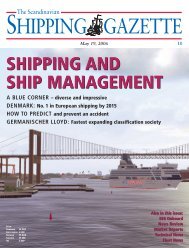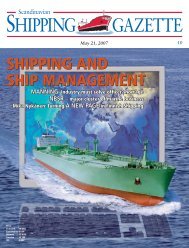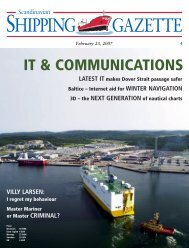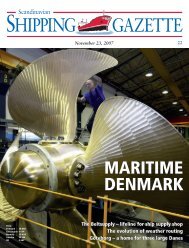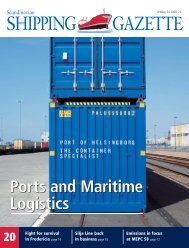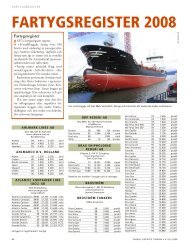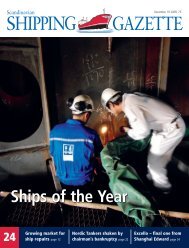SSG No 20 - Shipgaz
SSG No 20 - Shipgaz
SSG No 20 - Shipgaz
You also want an ePaper? Increase the reach of your titles
YUMPU automatically turns print PDFs into web optimized ePapers that Google loves.
norway’s only iron ore port, narvik, handles<br />
around 16 million tons per year.<br />
after Rotterdam. <strong>No</strong>rway’s only iron ore<br />
port, Narvik, handles around 16 million<br />
tons per year, most of it exports from the<br />
Swedish mines at Kiruna. Third on the<br />
list, Karmsund, handles around 14 million<br />
tons, a lot of it Hydro’s aluminum products<br />
from their works at Karmøy. Number<br />
five on the list, Tønsberg, needs an explanatory<br />
note, as the port area includes Esso’s<br />
Slagen Refinery.<br />
Container capacity increases<br />
<strong>No</strong>rwegian ports handled 152,250 TEUs,<br />
carrying 1.05 million tons during the first<br />
quarter of <strong>20</strong>07, up from 149,567 TEUs,<br />
carrying 1.02 million tons in the first quarter<br />
of <strong>20</strong>06. Most of the <strong>No</strong>rwegian container<br />
capacity is concentrated around the<br />
Oslo Fjord with Oslo as the country’s leading<br />
container port with 31 per cent of the<br />
traffic. Other important container ports<br />
in the Oslo Fjord area are Moss, Larvik,<br />
Kristiansand, Grenland and Borg, all with<br />
between 11,000 and 15,000 TEUs during<br />
the first quarter of the year.<br />
The offshore bases<br />
Bases servicing the offshore industry are not<br />
commercial ports in the traditional sense.<br />
Nevertheless these bases, dotted along the<br />
<strong>No</strong>rwegian coast from Stavanger to Hammerfest,<br />
provide the umbilical cord by<br />
which the platforms and rig offshore are<br />
connected to shore based facilities. According<br />
to official <strong>No</strong>rwegian statistics there are<br />
12 companies operating supply bases in <strong>No</strong>rway,<br />
some operating more than one base.<br />
Around 600 people work in these operating<br />
companies, which has a yearly turnover of<br />
just under NOK one billion. The ten most<br />
important offshore supply bases in <strong>No</strong>rway<br />
are Coast Center Base, Vestbase, Fjord Base,<br />
Risavika/Tananger, Sola Havn, Dusavik,<br />
Stordbase, Mongstadbase, Helgelandsbase<br />
and Polarbase. We once defined an offshore<br />
base as a catalyst of all the different players<br />
that provide the services the oil companies<br />
NORWAY’S lARGEST PORTS, TURNOVER<br />
(1,000 t) <strong>20</strong>03 <strong>20</strong>04 <strong>20</strong>05 <strong>20</strong>06 1st Qt <strong>20</strong>07<br />
Bergen 76,405 75,635 73,874 67,864 16,284<br />
Narvik 14,145 15,568 15,967 16,074 3,940<br />
Karmsund 13,505 13,360 14,093 14,085 3,790<br />
Grenland 9,773 9,656 9,805 10,155 2,769<br />
Tønsberg 10,5<strong>20</strong> 10,5<strong>20</strong> 9,886 11,491 2,708<br />
Oslo 6,021 6,141 5,978 6,410 1,614<br />
Molde & Romsdal 157 136 <strong>20</strong>3 6,148 1,585<br />
Kristiansund & <strong>No</strong>rdmøre 1,806 4,546 5,004 5,910 1,237<br />
Mo i Rana 2,983 3,648 3,488 3,428 921<br />
Drammen 2,211 2,823 3,159 2,940 910<br />
Borg 3,538 3,476 3,015 2,951 645<br />
Source: Statistics <strong>No</strong>rway<br />
require – services which include base organisation,<br />
installation service, supply vessel<br />
operation, helicopter service and a multitude<br />
of suppliers providing everything from<br />
food to steel piping.<br />
Sucked into politics<br />
Most <strong>No</strong>rwegian ports are municipal and<br />
as such sucked into local politics. The Port<br />
and Seaways Act of 1984 states clearly that<br />
ports are to retain financial autonomy and<br />
be self-financing. As such the ports ought<br />
to be independent. They are not, mainly<br />
because they work under the under the<br />
keen eye of of the Ministry of Fisheries and<br />
Coastal Affairs. This structure has often prevented<br />
reform. However, changes in modern<br />
logistics, environmental demands and a<br />
more progressive transport policy has led to<br />
a revision of the present Port and Seaways<br />
Act of 1984. The presumption is that a proposal<br />
will be put before the <strong>No</strong>rwegian parliament<br />
(Stortinget) before the end of this<br />
year. The present act needs modernising to<br />
include more recent policy measures.<br />
National Transport Plan<br />
In <strong>20</strong>03 a National Transport Plan (NTP)<br />
for the period <strong>20</strong>06 to <strong>20</strong>15 was adopted<br />
to integrate all modes of transport into one<br />
national plan. One central objective is to<br />
enforce intermodality in the transport sector<br />
and to shift more cargo from land to<br />
sea. So far the measures embedded in the<br />
NTP have not been carried out successfully.<br />
Rather, domestic sea transport continues<br />
to lose out, particularly to road transport.<br />
With the high seaways fees sea transport is<br />
for all intent and purposes subsidising road<br />
transport. The NTP does not address this<br />
problem and, until it does, the balance will<br />
not be redressed. A revised NTP for the<br />
period <strong>20</strong>10 to <strong>20</strong>19 is unlikely to grapple<br />
PORTs & MaRITIME lOGIsTICs<br />
NORWAY’S TEN lARGEST<br />
CONTAINER PORTS<br />
(TEU turnover) 1st Qt <strong>20</strong>07<br />
Oslo 46,903<br />
Moss 14,605<br />
Larvik 11,540<br />
Kristiansand 11,390<br />
Grenland 11,317<br />
Ålesund 9,455<br />
Bodø 8,659<br />
Borg 7,299<br />
Bergen 6,<strong>20</strong>8<br />
Stavanger 5,289<br />
Source: Statistics <strong>No</strong>rway<br />
with the politically thorny balance between<br />
the sea and land modes of transport. All<br />
they have done so far is to reclassify ports<br />
into national ports and other ports. The<br />
national ports are supposed to be intermodal,<br />
the other ports are either less efficient<br />
or do otherwise not qualify according to<br />
the European Union. The notion is that<br />
<strong>No</strong>rwegian ports by and large are too small<br />
to be a fully integrated link in intermodality,<br />
i.e. the transport chain with two or<br />
more modes of transport involved.<br />
Too many ports<br />
When King Eystein ordered a breakwater<br />
built at Agdenes in the thirteenth century<br />
he started what can only be termed a prolific<br />
port building program. We noted earlier<br />
that around 300 communities are bordering<br />
the sea. They all have their own port,<br />
in some cases fishing ports and they are<br />
open for business. The abundance of port<br />
facilities, but too little cargo to go around,<br />
is an inherent of all <strong>No</strong>rwegian ports. But<br />
too reduce the number of ports is politically<br />
very difficult, if not impossible.<br />
petter arentz<br />
sCanDInavIan sHIPPInG GaZETTE • OCTOBER 26, <strong>20</strong>07 61




